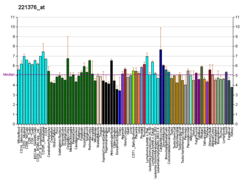
Summary
Fibroblast growth factor 17 is a protein that in humans is encoded by the FGF17 gene.[5][6][7]
| FGF17 | |||||||||||||||||||||||||||||||||||||||||||||||||||
|---|---|---|---|---|---|---|---|---|---|---|---|---|---|---|---|---|---|---|---|---|---|---|---|---|---|---|---|---|---|---|---|---|---|---|---|---|---|---|---|---|---|---|---|---|---|---|---|---|---|---|---|
| Identifiers | |||||||||||||||||||||||||||||||||||||||||||||||||||
| Aliases | FGF17, FGF-13, HH20, FGF-17, fibroblast growth factor 17 | ||||||||||||||||||||||||||||||||||||||||||||||||||
| External IDs | OMIM: 603725 MGI: 1202401 HomoloGene: 2872 GeneCards: FGF17 | ||||||||||||||||||||||||||||||||||||||||||||||||||
| |||||||||||||||||||||||||||||||||||||||||||||||||||
| |||||||||||||||||||||||||||||||||||||||||||||||||||
| |||||||||||||||||||||||||||||||||||||||||||||||||||
| |||||||||||||||||||||||||||||||||||||||||||||||||||
| |||||||||||||||||||||||||||||||||||||||||||||||||||
| Wikidata | |||||||||||||||||||||||||||||||||||||||||||||||||||
| |||||||||||||||||||||||||||||||||||||||||||||||||||
The protein encoded by this gene is a member of the fibroblast growth factor (FGF) family. FGF family members possess broad mitogenic and cell survival activities and are involved in a variety of biological processes, including embryonic development cell growth, morphogenesis, tissue repair, tumor growth, and invasion. This gene was shown to be prominently expressed in the cerebellum and cortex. The mouse homolog of this gene was localized to specific sites in the midline structures of the forebrain, the midbrain-hindbrain junction, developing skeleton and developing arteries, which suggests a role in central nervous system, bone and vascular development. This gene was referred to as FGF-13 in reference 2, however, its amino acid sequence and chromosomal localization are identical to FGF17.[7]
References edit
- ^ a b c GRCh38: Ensembl release 89: ENSG00000158815 – Ensembl, May 2017
- ^ a b c GRCm38: Ensembl release 89: ENSMUSG00000022101 – Ensembl, May 2017
- ^ "Human PubMed Reference:". National Center for Biotechnology Information, U.S. National Library of Medicine.
- ^ "Mouse PubMed Reference:". National Center for Biotechnology Information, U.S. National Library of Medicine.
- ^ Hoshikawa M, Ohbayashi N, Yonamine A, Konishi M, Ozaki K, Fukui S, Itoh N (Apr 1998). "Structure and expression of a novel fibroblast growth factor, FGF-17, preferentially expressed in the embryonic brain". Biochem Biophys Res Commun. 244 (1): 187–91. doi:10.1006/bbrc.1998.8239. PMID 9514906.
- ^ Greene JM, Li YL, Yourey PA, Gruber J, Carter KC, Shell BK, Dillon PA, Florence C, Duan DR, Blunt A, Ornitz DM, Ruben SM, Alderson RF (Oct 1998). "Identification and characterization of a novel member of the fibroblast growth factor family". Eur J Neurosci. 10 (5): 1911–25. doi:10.1046/j.1460-9568.1998.00211.x. PMID 9751161. S2CID 26104531.
- ^ a b "Entrez Gene: FGF17 fibroblast growth factor 17".
Further reading edit
- Bonaldo MF, Lennon G, Soares MB (1997). "Normalization and subtraction: two approaches to facilitate gene discovery". Genome Res. 6 (9): 791–806. doi:10.1101/gr.6.9.791. PMID 8889548.
- Xu J, Lawshe A, MacArthur CA, Ornitz DM (1999). "Genomic structure, mapping, activity and expression of fibroblast growth factor 17". Mech. Dev. 83 (1–2): 165–78. doi:10.1016/S0925-4773(99)00034-9. PMID 10381577. S2CID 14538640.
- Xu J, Liu Z, Ornitz DM (2000). "Temporal and spatial gradients of Fgf8 and Fgf17 regulate proliferation and differentiation of midline cerebellar structures". Development. 127 (9): 1833–43. doi:10.1242/dev.127.9.1833. PMID 10751172.
- Strausberg RL, Feingold EA, Grouse LH, et al. (2003). "Generation and initial analysis of more than 15,000 full-length human and mouse cDNA sequences". Proc. Natl. Acad. Sci. U.S.A. 99 (26): 16899–903. Bibcode:2002PNAS...9916899M. doi:10.1073/pnas.242603899. PMC 139241. PMID 12477932.
- Clark HF, Gurney AL, Abaya E, et al. (2003). "The Secreted Protein Discovery Initiative (SPDI), a Large-Scale Effort to Identify Novel Human Secreted and Transmembrane Proteins: A Bioinformatics Assessment". Genome Res. 13 (10): 2265–70. doi:10.1101/gr.1293003. PMC 403697. PMID 12975309.
- Ota T, Suzuki Y, Nishikawa T, et al. (2004). "Complete sequencing and characterization of 21,243 full-length human cDNAs". Nat. Genet. 36 (1): 40–5. doi:10.1038/ng1285. PMID 14702039.
- Polnaszek N, Kwabi-Addo B, Wang J, Ittmann M (2004). "FGF17 is an autocrine prostatic epithelial growth factor and is upregulated in benign prostatic hyperplasia". Prostate. 60 (1): 18–24. doi:10.1002/pros.20026. PMID 15129425. S2CID 22340970.
- Popovici C, Conchonaud F, Birnbaum D, Roubin R (2004). "Functional phylogeny relates LET-756 to fibroblast growth factor 9". J. Biol. Chem. 279 (38): 40146–52. doi:10.1074/jbc.M405795200. PMID 15199049.
- Gerhard DS, Wagner L, Feingold EA, et al. (2004). "The Status, Quality, and Expansion of the NIH Full-Length cDNA Project: The Mammalian Gene Collection (MGC)". Genome Res. 14 (10B): 2121–7. doi:10.1101/gr.2596504. PMC 528928. PMID 15489334.
- Iram T, Kern F, Kaur A, Myneni S, Morningstar AR, Shin H, Wyss-Coray T, et al. (2022). "Young CSF restores oligodendrogenesis and memory in aged mice via Fgf17". Nature. 605 (7910): 509–515. Bibcode:2022Natur.605..509I. doi:10.1038/s41586-022-04722-0. PMC 9377328. PMID 35545674.







